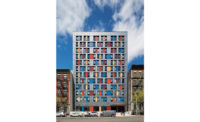The revolutionary Spangen social-housing complex (1919-1921) in Rotterdam, by Michiel Brinkman, has recently been immaculately restored. The project pioneered “street in the sky” deck access, an idea that famously inspired Alison and Peter Smithson’s design of the 1950s Golden Lane housing project in London. The Spangen estate, or Justus van Effen complex, is a rectangular four-story brick urban block, centered around two large courts. Concrete balconies give access to the duplex apartments on the top floors. In its heyday, the project offered many shared amenities, like a public bathhouse located between the two courtyards. A communal spirit was further promoted by making the decks publicly accessible; large cargo lifts allowed tradesmen to reach tenants’ front doors.
In 2006, Spangen’s owner, housing corporation Woonstad, embarked on a $41.1 million renovation of the run-down 194,630-square-foot complex. A previous 1985 renovation, by Leo de Jonge, was cost-driven; in spite of the building’s landmark status, the modernization of the units took precedence over maintaining the building’s architectural integrity. The 264 units were merged into 164 larger ones, the original interiors stripped, window frames replaced with aluminum, and the masonry painted white and gray.
For the most recent renovation (2010-2012), the goal of the design team—Molenaar & Co, Hebly Theunissen, and Michael van Gessel—was to restore the quality of the original architecture while meeting current standards of energy efficiency and comfort. The plan of the original 500-square-foot units was restored, and some units were combined to create 2,000-square-foot town houses (for a total of 154 units). The yellow-and-red-brick facade was cleaned and repaired, and woodwork was painted in original shades of white, green, and ochre.
Woonstad offered some units for sale, while maintaining others as affordable rentals, placing small businesses in the former bathhouse. The project benefits from the income mix, but the part-privatization of this iconic social housing project also reflects an unfortunate development in the once-progressive housing policies of the Netherlands. The housing corporations were privatized in 1994 and can no longer afford to add new social housing, let alone drive urban regeneration as they used to. A tax initiated in 2013 on the assets of the housing corporations will result in higher rents for lower-income tenants and is likely to bring building of social housing to a close, a reality that mocks the spirit of collectivity in which Spangen was originally conceived.











Post a comment to this article
Report Abusive Comment